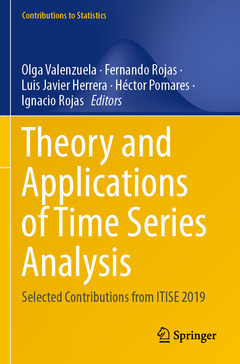Description
Theory and Applications of Time Series Analysis, 1st ed. 2020
Selected Contributions from ITISE 2019
Contributions to Statistics Series
Coordinators: Valenzuela Olga, Rojas Fernando, Herrera Luis Javier, Pomares Héctor, Rojas Ignacio
Language: English
Subjects for Theory and Applications of Time Series Analysis:
Keywords
time series analysis; forecasting theory and adjustment; econometric models and forecasting; complex and big data time series; hierarchical forecasting; energy forecasting; financial forecasting; times series in energy; time series with computational intelligence; prediction of time series; artificial intelligence; pattern recognition; statistical methods for time series; risk analysis; mathematical finance
Publication date: 11-2021
460 p. · 15.5x23.5 cm · Paperback
Publication date: 11-2020
460 p. · 15.5x23.5 cm · Hardback
Description
/li>Contents
/li>Biography
/li>Comment
/li>
This book presents a selection of peer-reviewed contributions on the latest advances in time series analysis, presented at the International Conference on Time Series and Forecasting (ITISE 2019), held in Granada, Spain, on September 25-27, 2019. The first two parts of the book present theoretical contributions on statistical and advanced mathematical methods, and on econometric models, financial forecasting and risk analysis. The remaining four parts include practical contributions on time series analysis in energy; complex/big data time series and forecasting; time series analysis with computational intelligence; and time series analysis and prediction for other real-world problems. Given this mix of topics, readers will acquire a more comprehensive perspective on the field of time series analysis and forecasting.
The ITISE conference series provides a forum for scientists, engineers, educators and students to discuss the latest advances and implementations in the foundations, theory, models and applications of time series analysis and forecasting. It focuses on interdisciplinary research encompassing computer science, mathematics, statistics and econometrics.
Olga Valenzuela is an Associate Professor at the Department of Applied Mathematics, University of Granada, Spain, where she received her Ph.D. in 2003. She has worked as an invited researcher at the Department of Statistics, University of Jaen, Spain, and at the Department of Computer and Information Science, University of Genova, Italy. Her research interests include optimization theory and applications, statistical analysis, fuzzy systems, neural networks, time series forecasting using linear and non-linear methods, evolutionary computation and bioinformatics. She has published more than 65 papers listed in the Web of Science.
Fernando Rojas is an Associate Professor at the University of Granada, Spain, where he received his Ph.D. in 2004. His research focuses on signal processing, artificial intelligence techniques for optimization, including evolutionary computation, fuzzy logic, neural networks etc., and the study of computer architectures for parallel processing in complex problems, such as time series prediction. He has published over 25 articles in JCR-indexed journals. A former coordinator of the Master’s Degree in Computer and Network Engineering at the University of Granada, he has been the secretary of the Master’s Degree in Data Science and Computer Engineering since 2014, and the secretary of the Department of Architecture and Computer Technology at the University of Granada since 2018.
Luis Javier Herrera is an Associate Professor at the University of Granada, Spain, where he received his Ph.D. in 2006. His research focuses on machine learning techniques (fuzzy logic, deep learning, genetic algorithms, etc.), and on their optimization and application over a wide range of scientific problems related to classification, approximation and time series prediction, sometimes requiring high-performance computing systems. These applications include relevant problems in several fields such as biomedicine, bioinformati
Updates the reader on the latest advances in time series analysis and forecasting
Highlights a variety of real-world applications in energy forecasting, computational intelligence and forecasting big data problems
Brings together experts from various disciplines, ranging from statistics to econometrics and computer science




